

Concept-Based Unit Mapping – Making Good Humans. Back in the fall, all of our teachers participated in an Inquiry workshop.
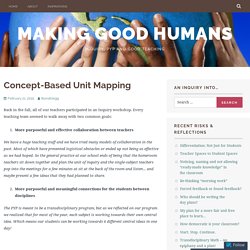
Every teaching team seemed to walk away with two common goals: More purposeful and effective collaboration between teachers We have a huge teaching staff and we have tried many models of collaboration in the past. Most of which have presented logistical obstacles or ended up not being as effective as we had hoped. Concept-based instruction in two simple words: uncover, transfer – Education to Save the World. A few years ago, my colleague Dave made these amazing stickers to help the concept-based model “stick” in teachers’ brains.
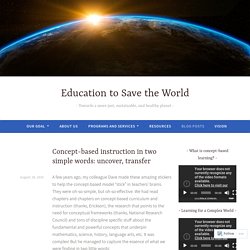
They were oh-so-simple, but oh-so-effective. We had read chapters and chapters on concept-based curriculum and instruction (thanks, Erickson), the research that points to the need for conceptual frameworks (thanks, National Research Council) and tons of discipline specific stuff about the fundamental and powerful concepts that underpin mathematics, science, history, language arts, etc. It was complex! But he managed to capture the essence of what we were finding in two little words: In these two words, his stickers summed up the most important principles of concept-based instruction, and helped teachers avoid the two most common pitfalls. Concept-based instruction starts with uncoverage.
Struggling with concepts? This might help! – Education to Save the World. When we work with teachers to shift toward concept-based instruction things tend to follow a distinct pattern, a roller coaster that flows from over-excitement to near abandonment and back again. image credit: gannett-cdn.com First, there is incredible eagerness and enthusiasm.

This makes so much sense! YES! What does a concept-based classroom look like? – Education to Save the World. The most important point to remember for a concept-based classroom is that the students come up with the generalization of conceptual understanding!

That is why Guiding Questions are so important. A key component of unit planning is writing factual, conceptual and provocative questions that correspond to the generalization and lead students to discover it. You should also choose a mix of understanding, knowledge and skills as the goals of your lesson. Throwback Thursday: The Power of the Conceptual Lens – Education to Save the World. Teaching students to learn conceptually – Education to Save the World.
Planning is done.
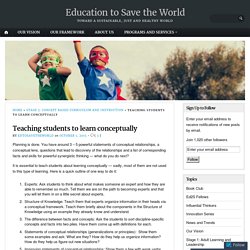
You have around 3 – 5 powerful statements of conceptual relationships, a conceptual lens, questions that lead to discovery of the relationships and a list of corresponding facts and skills for powerful synergistic thinking — what do you do next? It is essential to teach students about learning conceptually — sadly, most of them are not used to this type of learning. Here is a quick outline of one way to do it: Experts: Ask students to think about what makes someone an expert and how they are able to remember so much. What does it look like to teach students to learn conceptually? – Education to Save the World. Last week we posted a general outline of teaching students to learn conceptually.

Today we apply the outline to an actual class — 6th grade social studies. Here’s the context: The teacher worries that it might feel abrupt to suddenly begin being explicit about conceptual learning in the middle of the unit. A potential solution? Making Teaching Visible: 5 steps to teach concepts ... in math. Last year, I shared a blog post with friends and colleagues on Facebook entitled "Are You Doing It Wrong?

How to Introduce Telling Time" by Cindy Lee of Ainslee Labs (which has since been reposted here: Avoid the biggest mistake teachers make when teaching time ). It caught the attention of my second grade colleagues and now together, we're trying to figure out how to put Ms. Lee's ideas into practice with students. Concept-Based Unit Mapping – Making Good Humans. Concept based learning… – What Ed Said. ‘Hands up if you often forget the things you learn in class.’ ‘Hands up if you’re sometimes overwhelmed by information overload.’ Both times, all hands go up, including mine and Jocelyn’s.
I’m in her Year 6 class to help them consider the big ideas in their learning and develop their understanding of concepts. This will assist them to organise information in future, explore significant ideas, promote higher order thinking and deepen inquiry. I show them the avocado model… They quickly get the idea that the big ideas we remember, long after we have forgotten the details, become the seeds from which new learning grows. What is a ‘big idea’? 3 Steps to a Successful Concept-Based Unit – Education to Save the World. You’ve read all the books (or at least a few blog posts) on concept-based curriculum.
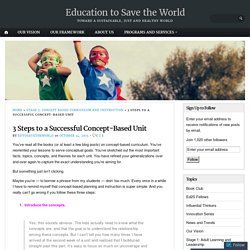
You’ve reoriented your lessons to serve conceptual goals. You’ve sketched out the most important facts, topics, concepts, and theories for each unit. You have refined your generalizations over and over again to capture the exact understanding you’re aiming for. But something just isn’t clicking. Maybe you’re — to borrow a phrase from my students — doin’ too much. Introduce the concepts. Yes, this sounds obvious. 2. Sometimes I get frustrated when student thinking remains stagnant and my instruction seems only to reinforce shallow, superficial views of the concepts. Concept driven learning… – What Ed Said.
Some ‘big ideas’ about concept driven learning: (From this week’s little #pypchat on Twitter) The world is changing.
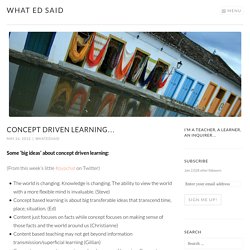
Knowledge is changing. The ability to view the world with a more flexible mind is invaluable. (Steve)Concept based learning is about big transferable ideas that transcend time, place, situation. Big Ideas in the classroom. Imagine there’s no…..Conceptual Understandings. Imagine there’s no…..Conceptual Understandings Conceptual understandings.
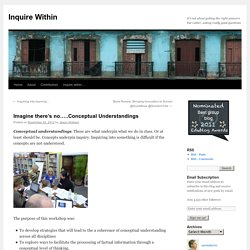
These are what underpin what we do in class. Or at least should be. Concepts underpin inquiry. Inquiring into something is difficult if the concepts are not understood. Conceptual Understanding and Misunderstanding! Something interesting happened the other day in my maths class. We had started a new topic, Division. I asked the students to turn on their laptops and talk about their understanding of division.
They loved watching themselves talk. Some even put on an accent in order to sound posh! Watching the videos, it was clear that some students had a fair understanding of what division was, while other students had no clue. As this was a completely new topic in grade 3, the students started warming up to it using ice cream sticks, which we had in plenty. At one point I asked them to take a number of stick which will result in there being a remainder. Planning for concept driven learning… – What Ed Said. Cross-posted at Inquire within, following on from Inquiry: to what end?
By Cristina Milos. How do we assess understanding? – What Ed Said. Part of my role as Teaching and Learning Coordinator involves facilitating and supporting the planning of units of inquiry. Planning for inquiry can be difficult. On the one hand, over planning limits the potential for inquiry. On the other hand, we have desired outcomes and understandings, as well as the demands of a national curriculum.
We used to plan a range of learning experiences in advance. You can read here about how we have improved our planning process. Nowadays, we start by identifying the desired conceptual understandings and carefully considering what evidence will indicate that our learners have achieved them. Keeping an eye on the conceptual understandings allows us to add further targeted provocations as the inquiry unfolds. Creating a rubric helps clarify where our units are heading. More on concept driven inquiry… In a concept driven, inquiry based learning environment, we do NOT plan a series of activities to ensure coverage of the requirements of our national curriculum.
Instead we spend our planning time reflecting collaboratively, exploring which conceptual lenses will produce the deepest learning and designing a few powerful provocations to generate student thinking and inquiry. The Australian curriculum expects us to ‘cover’ a large amount of geographical knowledge in Year 6 including, among other things – The location of the major countries of the Asia region in relation to Australia and the geographical diversity within the region.Differences in the economic, demographic and social characteristics between countries across the world.The various connections Australia has with other countries and how these connections change people and places.The effects that people’s connections with, and proximity to, places throughout the world have on shaping their awareness and opinion of those places.